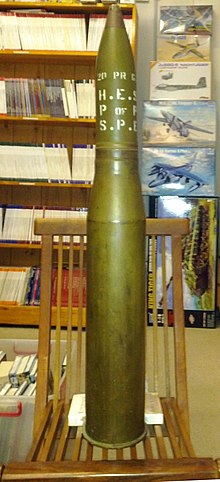Ordnance QF 20-pounder
This article may require cleanup to meet Wikipedia's quality standards. The specific problem is: Messy and unorganised article; needs expansion for content. (May 2016) |
| Ordnance QF 20 pounder Mark I | |
|---|---|
 Charioteer tank equipped with the 20 pounder. This gun is a later model which is fitted with a bore evacuator | |
| Type | tank gun |
| Place of origin | United Kingdom |
| Service history | |
| In service | 1948–1970s |
| Used by | United Kingdom Australia Austria Canada Finland Israel Jordan Lebanon South Africa |
| Wars | Korean War Vietnam War Six-Day War South African Border War |
| Specifications | |
| Length | 226.4 in (5.75 m), 66.7 calibres |
| Shell | 20 pounds (9.07 kg) |
| Calibre | 84 millimetres (3.31 in) |
| Elevation | +18 to −10 in Centurion Mk 5 |
The Ordnance QF 20 pounder (known as 20 pounder, 20 pdr or simply 20-pr) was a British 84 mm (3.307 inch) tank gun.[1][i]
It was introduced in 1948 and used in the Centurion main battle tank, Charioteer medium tank, and Caernarvon Mark II heavy tank.
It was the improved successor to the effective Ordnance QF 17 pounder and the predecessor of the 105 mm L7 gun.
Design and development
The gun was developed by the Royal Ordnance Factories.
As fitted to the Charioteer, it ran through two models:
- Model A without a fume extractor.
- Model B with a fume extractor.
The L7 105 mm tank gun was developed from the 20 pounder. In 1954, the original version of the 105 mm was made by re-boring the tube of a 20 pounder barrel.[2]
Service history
The gun was fitted predominantly to the Centurion tank, seeing action with British and Australian forces.
One gun was fitted to a Swiss pre-production Panzer 58.[3]
Performance
The 20 pounder's APCBC projectile had an initial muzzle velocity of 1,020 metres per second and could penetrate 210 mm (8.3 in) of rolled homogeneous armour (RHA). However, these conventional rounds were rarely used.
The APDS projectile had a muzzle velocity of 1,465 m/s (4,810 ft/s) and the APDS Mk.3 shell could penetrate 330 mm (13 in) of RHA at a distance of 1000 yard.[4][5][ii][6]
The 20-pounder could also fire high-explosive, HESH and canister shot shells.
Ammunition

| Round | Muzzle velocity[7] |
|---|---|
| APDS | 4,700 ft/s |
| HE | 1,975 ft/s |
| Canister | 3,000 ft/s |
| Smoke | 825 ft/s |
Footnotes
Notes
References
- ^ Pugh (1962), p. 34.
- ^ Ogorkiewicz (1991), p. 70.
- ^ Ford (1997), p. 121.
- ^ "British Anti-Tank Gunnery Data". figuras.miniatures.de.[unreliable source?]
- ^ Dunstan (2003), p. 10.
- ^ Archive:Tank effectiveness: Conqueror, Conway and Charioteer & WO 291/1416 (1954), p. 9.
- ^ Norman (1967), p. 12.
Bibliography
- Dunstan, Simon (2003). Centurion Universal Tank 1943-2003. Oxford, UK: Osprey Publishing. ISBN 1-84176-387-X.
{{cite book}}: Invalid|ref=harv(help). - Ford, Roger (1997). The World's Great Tanks from 1916 to the present day. Brown Packaging Books Ltd. ISBN 1-897884-29-X.
{{cite book}}: Invalid|ref=harv(help) - Norman, Michael (1967). Armour in Profile (Number 23), Centurion 5. Surrey: Profile Publications Ltd.
{{cite book}}: Invalid|ref=harv(help) - Ogorkiewicz, Richard (1991). Technology of Tanks. London, UK: Jane's Information Group, Ltd. ISBN 0-7106-0595-1.
{{cite book}}: Invalid|ref=harv(help). - Pugh, Stevenson (1962). Fighting Vehicles and Weapons of the Modern British Army. Macdonald & Co. OCLC 10010960.
{{cite book}}: Invalid|ref=harv(help)
See also
- Pounds as a measure of cannon bore
- British standard ordnance weights and measurements
- Ordnance QF 32-pounder
